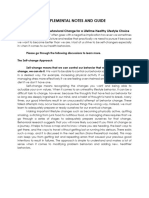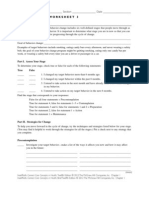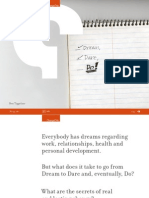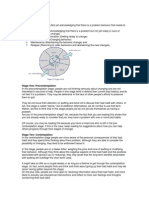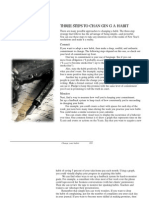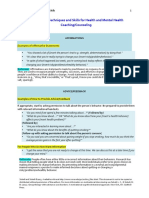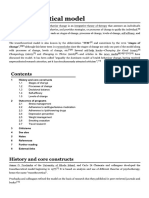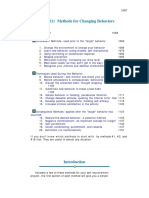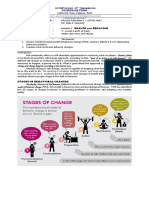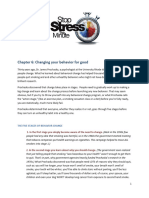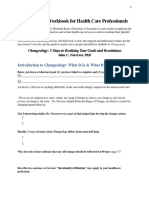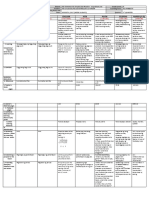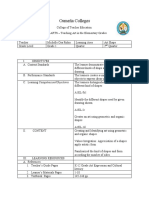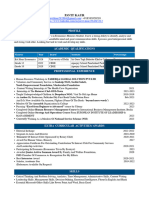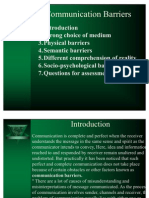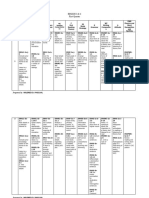Module 13.
5 – How to Change Behavior Patterns
Changing Individual Team Member Behavior Questionnaire
Name Team
Stages of Change
To change behavior people experience six well-defined stages. It is important to
determine what stage you are experiencing so that you can choose appropriate
techniques for progressing through the cycle of change.
List Target behavior/problem: What behavior during the life of your project, while
working with your team would you personally like to change before working on another
team? Choose any issue, attitude, and behavior, even a bad habit that you want to
address.
How repetitive was the behavior?
List Goal of behavior change: What are my goals when I engage in this behavior/way of
thinking, feeling, believing, or acting? In other words, what am I getting out of doing it?
Examples of target behaviors include being late to meetings, missing internal deadlines,
not speaking up when you disagree with other team members, procrastinating, being
frustrated over equipment failures or incomplete data analysis;
Part I. Assess Your Stage
To determine your stage, state if true or false for each of the following statements:
1. I changed my target behavior more than 6 months ago.
2. I changed my target behavior within the past 6 months.
3. I intend to take action in the next month and have already made a few small changes
in my behavior.
4. I intend to take action on my target behavior in the next 6 months.
Find the stage that corresponds to your responses:
False for all four statements = Precontemplation
True for statement 4, false for statements 1–3 = Contemplation
True for statements 3 and 4, false for statements 1 and 2 = Preparation
True for statement 2, false for statement 1 = Action
1
�True for statement 1 = Maintenance
Part II. Strategies for Change
To help you move forward in the cycle of change, try the techniques and strategies
listed for your stage. (You may find it helpful to work through the strategies for all the
stages.) Investigate your target behavior—make a list of the ways it affects you now and
how it may affect you in the future:
Precontemplation
1. Do I want to stop this behavior or do I just feel compelled by outside pressure?
2. What is my relationship with other team members and the way I utilize that
relationship that allows me to continue this behavior, or to stop this behavior? This is a
point often not considered. People that we hang out with may hold the same attitudes
or beliefs and there may be pressure from the group not to change.
3. Am I capable of stopping this behavior? In other words, how do I know I can stop?
Become aware of the mental defenses you use to resist change; examples of defenses
include denying the consequences of your target behavior and rationalizing your
reasons for not changing. List some of the key mental defense mechanisms that you use
to resist change:
Enlist friends and team members to help you learn more about your target behavior and
the defenses that block your progress. List the people you have spoken with, and briefly
describe what they told you about the defense mechanisms you use:
Identify and list community resources that can help you change your target behavior—
for example, a stress-management workshop, going to S3, seeing a therapist:
Contemplation
2
�Engage your emotions through strategies such as imagining your life without changing,
watching movies related to your target behavior, and becoming more aware of the
current effects of your target behavior (for example, ). List the strategies you tried:
1. By what means can I stop this behavior? What do I need to do in order to stop
thinking, acting, behaving this way?
2. What is my orientation, when I engage in this behavior, or when I stop this behavior?
Where is this behavior leading me in either case?
3. What do I have to eliminate in order to stop this behavior? What other behavior(s)
do I need to let go in order to stop doing what I’m doing?
Keep a journal of your target behavior to establish a baseline. Examine the behaviors
that lead up to and follow your target behavior. Complete a cost-benefit analysis of your
target behavior:
What are the advantages for using this current behavior?
What are the disadvantages for you in using this current behavior?
Create a new self-image: imagine yourself and your life after you change your target
behavior:
What will help you support this change?
3
�
Enlist the help of friends and team members to support your efforts and help you
identify the causes and consequences of your target behavior. List the people you’ve
spoken with, and briefly describe what they told you about your target behavior:
Preparation
Make change a priority in your life; plan to commit the necessary time and effort to
change. Create a specific plan for change. Tell the people in your life about the change
you’ll be making, and enlist their help. List the people you’ve spoken with and how they
will help you change this specific behavior:
1. What do I have to understand or research to stop this behavior? What must I focus
on to change this conditioned behavior?
2. What must I do to bring my impulses in line with stopping this behavior? How do I
extinguish the impulses/desire that perpetuates the behavior? Can I substitute another
thought or action in place of the impulse?
3. What are my needs when I engage in this behavior and when I stop this behavior? Do
I really need this behavior or just want or like having it? What habitual activities that
support this behavior must be eliminated?
Action
Use a journal to monitor your behavior. Substitute healthier responses for your problem
behavior. Identify ways to break the chain of events that leads to your target behavior.
Manage your stress level, and don’t let yourself get overwhelmed.
1. What are the other possibilities in relationship to this behavior? What positive
behaviors can potentially replace old negative patterns of behavior?
4
�2. What is the form this behavior takes? Describe detail by detail how this behavior is
carried out on an ongoing basis including thoughts and reactions to these thoughts. Is
this behavior really important to your being? (If this is hard using an issue of your own
choosing to work with, then use the example of being late to meetings. Step by step
think about all of the activities centered around being late, not just being late itself---
support for being late, using the time for other activities you personally find beneficial,
thinking about how to change, anxiety about not getting everything done, and on and
on.)
3. What is the substance of this behavior? What does this negative, limiting
behavior/attitude/belief really have to do with who I am?
List three strategies you’ll use during your behavior change program:
Tips for Change:
1. Practice positive, realistic self-talk
2. Make changes in your environment that will discourage your target behavior and
encourage healthier choices. Identify cues that trigger your target behavior and develop
strategies for avoiding them or making different choices.
3. Give yourself the rewards as well as plenty of self-praise.
4. Involve the people around you. Find a team member to work with you on change
and/or find a role model
5. Find someone who has already made the change you are working toward and who
can provide both inspiration and practical advice.
6. Keep a positive attitude about yourself and the change you are attempting. Don’t get
discouraged—the action stage typically lasts for at least several months.
Maintenance
Continue with all the positive strategies you used in the action stage.
Continue to monitor your behavior with a journal.
5
�Continue to manage your environment. Continue to practice realistic self-talk.
Guard against slips, but don’t let a slip set you back. Be prepared for complications.
Help someone else make the change that you have just made.
Termination
If you complete the previous five stages and are no longer tempted to lapse back to
your target behavior, you are in the termination stage. You have a new self-image,
positive feelings of self-efficacy, and a healthier lifestyle.
References
Insel/Roth, Core Concepts in Health, Tenth Edition © 2006 The McGraw-Hill Companies,
Inc. Chapter 1
Insel/Roth, Core Concepts in Health, Brief Tenth Edition © 2006 The McGraw-Hill
Companies, Inc. Chapter 1
Prochaska, J. O., J. C. Norcross, and C. C. DiClemente. 1994. Changing for Good: A
Revolutionary Six-Stage Program for Overcoming Bad Habits and Moving Your Life
Positively Forward. New York: Avon Books.
www.mhhe.com/insel10e or www.mhhe.com/inselbrief10e
